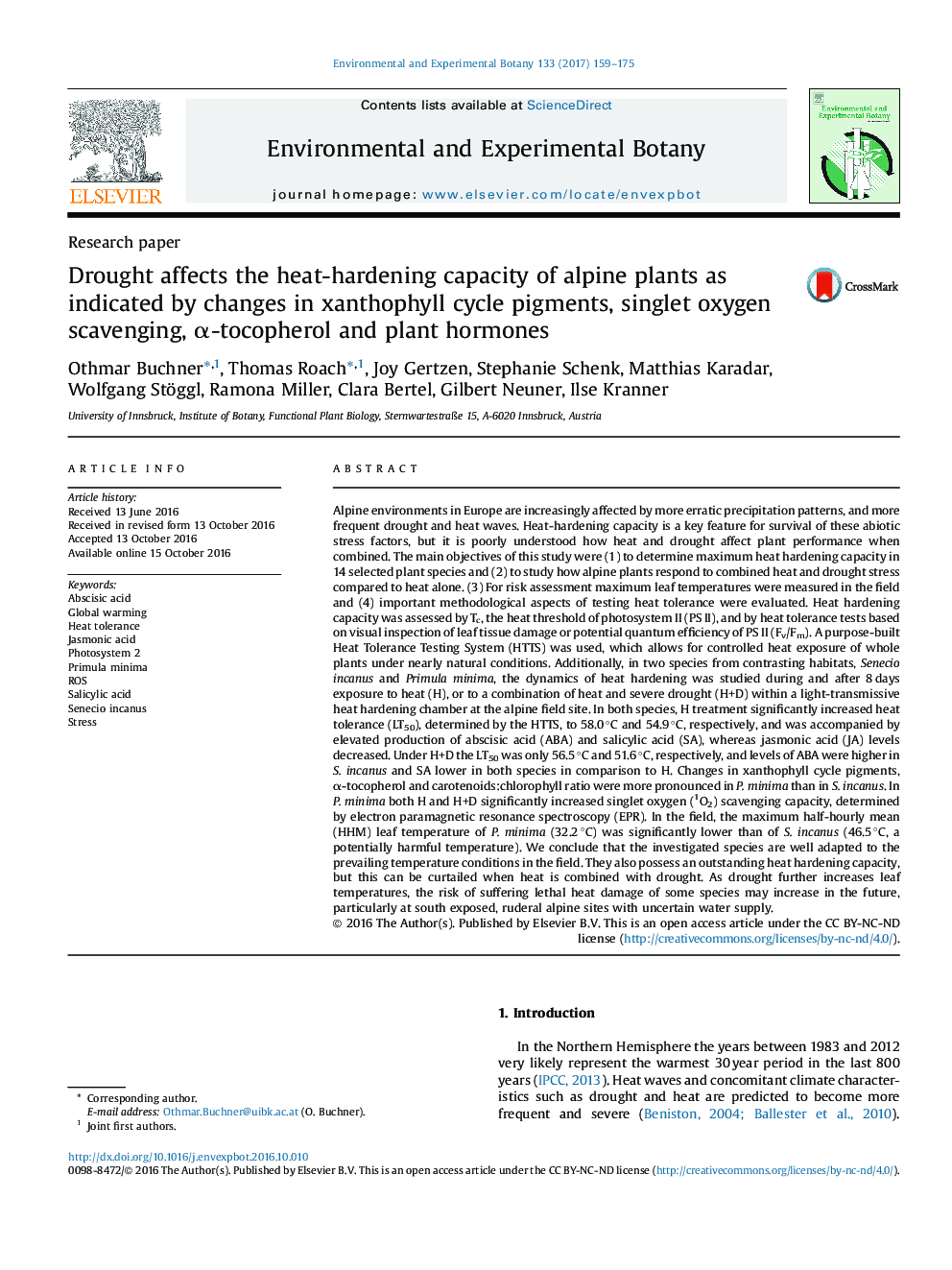| کد مقاله | کد نشریه | سال انتشار | مقاله انگلیسی | نسخه تمام متن |
|---|---|---|---|---|
| 6388832 | 1628044 | 2017 | 17 صفحه PDF | دانلود رایگان |

- Combined heat and drought stress can diminish the heat hardening capacity of leaves.
- Drought significantly enhances the effect of global warming on leaf temperature.
- The risk of suffering heat damage is increased on south exposed, ruderal alpine sites.
- Heat tolerance tests using detached leaves may have limited ecological relevance.
- Heat hardening is a multifaceted process which is orchestrated by hormonal crosstalk.
Alpine environments in Europe are increasingly affected by more erratic precipitation patterns, and more frequent drought and heat waves. Heat-hardening capacity is a key feature for survival of these abiotic stress factors, but it is poorly understood how heat and drought affect plant performance when combined. The main objectives of this study were (1) to determine maximum heat hardening capacity in 14 selected plant species and (2) to study how alpine plants respond to combined heat and drought stress compared to heat alone. (3) For risk assessment maximum leaf temperatures were measured in the field and (4) important methodological aspects of testing heat tolerance were evaluated. Heat hardening capacity was assessed by Tc, the heat threshold of photosystem II (PS II), and by heat tolerance tests based on visual inspection of leaf tissue damage or potential quantum efficiency of PS II (Fv/Fm). A purpose-built Heat Tolerance Testing System (HTTS) was used, which allows for controlled heat exposure of whole plants under nearly natural conditions. Additionally, in two species from contrasting habitats, Senecio incanus and Primula minima, the dynamics of heat hardening was studied during and after 8 days exposure to heat (H), or to a combination of heat and severe drought (H+D) within a light-transmissive heat hardening chamber at the alpine field site. In both species, H treatment significantly increased heat tolerance (LT50), determined by the HTTS, to 58.0 °C and 54.9 °C, respectively, and was accompanied by elevated production of abscisic acid (ABA) and salicylic acid (SA), whereas jasmonic acid (JA) levels decreased. Under H+D the LT50 was only 56.5 °C and 51.6 °C, respectively, and levels of ABA were higher in S. incanus and SA lower in both species in comparison to H. Changes in xanthophyll cycle pigments, α-tocopherol and carotenoids:chlorophyll ratio were more pronounced in P. minima than in S. incanus. In P. minima both H and H+D significantly increased singlet oxygen (1O2) scavenging capacity, determined by electron paramagnetic resonance spectroscopy (EPR). In the field, the maximum half-hourly mean (HHM) leaf temperature of P. minima (32.2 °C) was significantly lower than of S. incanus (46.5 °C, a potentially harmful temperature). We conclude that the investigated species are well adapted to the prevailing temperature conditions in the field. They also possess an outstanding heat hardening capacity, but this can be curtailed when heat is combined with drought. As drought further increases leaf temperatures, the risk of suffering lethal heat damage of some species may increase in the future, particularly at south exposed, ruderal alpine sites with uncertain water supply.
Journal: Environmental and Experimental Botany - Volume 133, January 2017, Pages 159-175